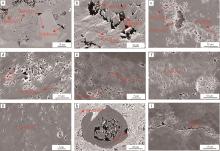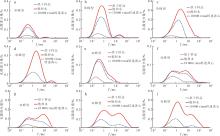

石油与天然气地质 ›› 2022, Vol. 43 ›› Issue (1): 149-160.doi: 10.11743/ogg20220112
王林生1( ), 叶义平1, 覃建华1, 高阳1, 邓远1,2(
), 叶义平1, 覃建华1, 高阳1, 邓远1,2( ), 李映艳1, 肖佃师3
), 李映艳1, 肖佃师3
收稿日期:2021-08-24
修回日期:2021-11-25
出版日期:2022-02-01
发布日期:2022-01-28
通讯作者:
邓远
E-mail:bkqwls@petrochina.com.cn;dengyuan_geo@163.com
第一作者简介:王林生(1978—),男,高级工程师,油气田开发。E?mail: 基金项目:
Linsheng Wang1( ), Yiping Ye1, Jianhua Qin1, Yang Gao1, Yuan Deng1,2(
), Yiping Ye1, Jianhua Qin1, Yang Gao1, Yuan Deng1,2( ), Yingyan Li1, Dianshi Xiao3
), Yingyan Li1, Dianshi Xiao3
Received:2021-08-24
Revised:2021-11-25
Online:2022-02-01
Published:2022-01-28
Contact:
Yuan Deng
E-mail:bkqwls@petrochina.com.cn;dengyuan_geo@163.com
摘要:
针对准噶尔盆地吉木萨尔凹陷二叠系芦草沟组页岩油储层类型多样和油层甜点预测难度大的问题,开展页岩油孔隙发育影响机制及含油性分级评价研究。在岩心观察的基础上,应用扫描电镜、压汞和核磁共振等手段,研究吉木萨尔凹陷二叠系芦草沟组页岩油储层的微观孔隙结构,揭示孔隙发育及含油性影响机制,建立油层分类评价标准。结果表明:①芦草沟组发育粒间孔型、粒间-溶蚀-晶间孔型、溶蚀孔型、溶蚀-晶间孔型和晶间孔型5类储层,其中粒间孔型和溶蚀孔型物性及可动性最好,晶间孔型最差。②较高的偏粗组分数量、适中的白云石含量和低胶结物含量共同决定优质储层形成,优质储层分布受近物源、高能环境及古凹的控制。③源-储互层或一体型配置模式含油性好于邻源厚层型,15 nm和70 nm为芦草沟组能否含油及含油性变好的孔喉半径界限。④以孔喉结构与含油性关系为指导,划分出Ⅰ类油层、Ⅱ类油层和Ⅲ类油层。芦草沟组一段二亚段优质储层发育,源-储配置佳,油层甜点分布规模大。研究成果为芦草沟组页岩油油层分类评价及甜点预测提供了地质依据。
中图分类号:
表1
准噶尔盆地吉木萨尔凹陷二叠系芦草沟组页岩油储层样品信息"
| 样品编号 | 含油级别 | 薄片鉴定岩性 | 孔隙度/% | 渗透率/(10-3 μm2) | 孔喉组合类型 | 全岩矿物含量/ % | 可动饱和度/ % | ||||
|---|---|---|---|---|---|---|---|---|---|---|---|
| 石英 | 长石 | 白云石 | 方解石 | 粘土 | |||||||
| 5?H | 荧光 | 泥岩 | 5.5 | 0.577 0 | E | 28.6 | 53.5 | 1.5 | 1.2 | 15.2 | 20.50 |
| 13?H | 荧光 | 白云质泥岩 | 6.9 | 0.055 9 | E | — | — | — | — | — | 13.83 |
| 17?H | 荧光 | 白云质泥岩 | 6.1 | 0.009 4 | E | 20.6 | 32.7 | 40.8 | 0 | 5.7 | 17.54 |
| 3 | 荧光 | 泥晶白云岩 | 4.3 | 0.003 0 | E | 29.3 | 43.3 | 12.9 | 4.7 | 7.6 | 44.13 |
| J43?95 | 油迹 | 灰质粉砂岩 | 5.6 | 0.008 5 | D | 9.4 | 49.7 | 1.5 | 36.3 | 3.1 | 22.69 |
| 13 | 油迹 | 含灰粉砂岩 | 5.1 | 0.011 9 | D | 14.1 | 53.2 | 6.5 | 21.2 | 3.3 | 36.89 |
| 10 | 油斑 | 泥岩 | 11.9 | 0.027 7 | D | 40.2 | 35.7 | 11.1 | 0 | 13.0 | 38.60 |
| 24 | 油斑 | 泥质粉砂岩 | 8.9 | 0.139 5 | D | 16.3 | 51.1 | 7.8 | 10.1 | 12.3 | 42.56 |
| 3?H | 油斑 | 粉砂质泥岩 | 14.7 | 0.061 8 | C | 37.5 | 48.0 | 2.6 | 3.8 | 5.2 | 37.90 |
| 39 | 油浸 | 粉砂质白云岩 | 14.9 | 0.046 9 | B | 6.4 | 5.3 | 88.3 | 0 | 0 | 54.80 |
| 2?H | 油浸 | 细粒粉砂岩 | 14.3 | 0.083 3 | A | 28.5 | 67.0 | 0 | 0 | 3.7 | 59.89 |
| 15?H | 油浸 | 含灰泥质粉砂岩 | 9.4 | 0.019 7 | B | 21.0 | 56.7 | 0 | 18.7 | 3.1 | 43.24 |
| 9?H | 富含油 | 云屑砂岩 | 14.0 | 0.289 0 | A | 12.0 | 74.2 | 2.4 | 9.8 | 1.6 | 70.20 |
| 32 | 富含油 | 细粒粉砂岩 | 15.6 | 0.107 5 | C | 22.1 | 59.2 | 5.1 | 0 | 6.4 | 69.80 |
| 10?H | 富含油 | 云屑砂岩 | 13.7 | 0.275 0 | A | 12.0 | 73.2 | 2.4 | 9.8 | 1.6 | 69.15 |
| 12?H | 富含油 | 砂屑云岩 | 14.6 | 1.320 0 | A | 4.5 | 29.2 | 40.4 | 24.2 | 1.7 | 77.32 |

图2
准噶尔盆地吉木萨尔凹陷二叠系芦草沟组页岩油储层孔隙扫描电镜特征a.残留粒间孔和粒内溶蚀孔发育,12-H号样品,砂屑白云石,埋深3 317.50 m,J10016井;b.残留粒间孔、粒间溶蚀孔和粒内溶蚀孔并存,39号样品,粉砂质白云岩,埋深2 715.15 m,Ji31井;c.溶蚀孔和粘土晶间孔,30-H号样品,云质粉砂岩,埋深3 469.90 m,J10022井;d.溶蚀孔和晶间孔,9号样品,粉砂质泥岩,埋深2 844.56 m,Ji37井;e.长石粒内溶蚀孔及方解石交代,J43-95号样品,灰质粉砂岩,埋深2 967.59 m,Ji43井;f.粘土晶间孔,30-H号样品,云质粉砂岩,埋深3 469.90 m,J10022井;g.白云石晶间孔,11号样品,泥晶白云岩,埋深2 856.41 m,Ji37井;h.有机孔和粒内溶蚀孔,3-H号样品,粉砂质泥岩,埋深3 296.40 m,J10016井;i.微裂缝和粒内溶蚀孔,24号样品,泥质粉砂岩,埋深3 756.38 m,Ji251井"


图4
准噶尔盆地吉木萨尔凹陷二叠系芦草沟组页岩油储层T2分布a.3号样品,晶间孔型组合,泥晶白云岩,埋深3 044.97 m,Ji176井;b.10号样品,溶蚀-晶间孔组合,页岩,埋深2 847.16 m,Ji37井;c.39号样品,粒间-溶蚀-晶间孔型组合,粉砂质白云岩,埋深2 715.15 m,Ji31井;d.30-H号样品,溶蚀孔型组合,云质粉砂岩,埋深3 469.90 m,J10022井;e.5-H号样品,晶间孔型,泥岩,埋深3 301.40 m,J10016井;f.J43-95号样品,溶蚀-晶间孔型,灰质粉砂岩,埋深2 967.59 m,Ji43井;g.15-H号样品,粒间-溶蚀-晶间孔型,含灰质粉砂岩,埋深3 452.20 m,J10016井;h.9-H号样品,粒间孔型,云屑粉砂岩埋深3 315.20 m,J10016井;i.12-H号样品,粒间孔型,砂屑白云岩,埋深3 317.50 m,J10016井"

| 1 | 匡立春,唐勇,雷德文,等.准噶尔盆地二叠系咸化湖相云质岩致密油形成条件与勘探潜力[J].石油勘探与开发,2012,39(6):657-667. |
| Kuang Lichun, Tang Yong, Lei Dewen, et al. Formation conditions and exploration potential of tight oil in the Permian saline lacustrine dolomitic rock, Junggar Basin, NW China[J]. Petroleum Exploration and Development,2012,39(6):657-667. | |
| 2 | 马克,侯加根,刘钰铭,等.吉木萨尔凹陷二叠系芦草沟组咸化湖混合沉积模式[J].石油学报,2017,38(6):636-648. |
| Ma Ke, Hou Jiagen, Liu Yuming, et al. The sedimentary model of saline lacustrine mixed sedimentation in Permian Lucaogou Formation, Jimsar Sag[J]. Acta Petrolei Sinica,2017,38(6):636-648. | |
| 3 | 金之钧,白振瑞,高波,等.中国迎来页岩油气革命了吗?[J].石油与天然气地质,2019,40(3):451-458. |
| Jin Zhijun, Bai Zhenrui, Gao Bo,et al. Has China ushered in the shale oil and gas revolution?[J].Oil & Gas Geology,2019,40(3):451-458. | |
| 4 | 张方,高阳,彭寿昌,等.湖相混积岩碳酸盐组分成岩作用及其孔隙结构特征——以新疆吉木萨尔凹陷二叠系芦草沟组为例[J].断块油气田,2020,27(5):567-572. |
| Zhang Fang, Gao Yang, Peng Shouchang,et al.Diagenesis and pore structure characteristics of carbonate component of lacustrine mixed rocks: A case study of Permian Lucaogou Formation in Jimusar Sag,Xinjiang[J].Fault⁃Block Oil and Gas Field,2020,27(5):567-572. | |
| 5 | 宋永,周路,郭旭光,等.准噶尔盆地吉木萨尔凹陷芦草沟组湖相云质致密油储层特征与分布规律[J]. 岩石学报,2017,33(4):1159-1170. |
| Song Yong, Zhou Lu, Guo Xuguang, et al. Characteristics and occurrence of lacustrine dolomitic tight-oilreservoir in the Middle Permian Lucaogou Formation,Jimusaer Sag,southeastern Junggar Basin[J]. Acta Petrologica Sinica,2017,33( 4) : 1159-1170 | |
| 6 | 王成云,匡立春,高岗,等.吉木萨尔凹陷芦草沟组泥质岩类生烃潜力差异性分析[J]. 沉积学报,2014,32(2):385-390. |
| Wang Chengyun, Kuang Lichun, Gao Gang, et al. Difference in hydrocarbon generation potiential of the shaly source rocks in Jimsar Sag, Permian Lucaogou Formation[J]. Acta Sedimentologica Sinica,2014,32(2):385-390. | |
| 7 | 王璟明,肖佃师,卢双舫,等.吉木萨尔凹陷芦草沟组页岩储层物性分级评价[J].中国矿业大学学报,2020,49(1):172-183. |
| Wang Jingming, Xiao Dianshi, Lu Shuangfang, et al. Classification evaluation of shale oil reservoir physical properties in Lucaogou Formation, Jimsar Sag[J]. Journal of China University of Mini⁃ng & Technology, 2020,49(1):172-183. | |
| 8 | 柳波,石佳欣,付晓飞,等.陆相泥页岩层系岩相特征与页岩油富集条件——以松辽盆地古龙凹陷白垩系青山口组一段富有机质泥页岩为例[J].石油勘探与开发,2018,45(5):828-838. |
| Liu Bo, Shi Jiaxin, Fu Xiaofei, et al. Petrological characteristics and shale oil enrichment of lacustrine fine⁃grained sedimentary system: A case study of organic⁃rich shale in first member of Cretaceous Qingshankou Formation in Gulong Sag, Songliao Basin, NE China[J]. Petroleum Exploration and Development,2018,45(5):828-838. | |
| 9 | 徐雄飞,于祥春,卿忠,等.三塘湖盆地芦草沟组岩相特征及其与页岩油藏的关系[J].新疆石油地质,2020,41(6):677-684. |
| Xu Xiongfei, Yu Xiangchun, Zhong Qing,et al. Lithofacies characteristics and its relationship with shale oil reservoirs of Lucaogou Formation in Santanghu Basin[J]. Xinjiang Petroleum Geology,2020,41(6):677-684. | |
| 10 | 王伟,赵延伟,毛锐,等.页岩油储层核磁有效孔隙度起算时间的确定——以吉木萨尔凹陷二叠系芦草沟组页岩油储层为例[J].石油与天然气地质,2019,40(3):550-557. |
| Wang Wei, Zhao Yanwei, Mao Rui, et al. Determination of the starting time for measurement of NMR effective porosity in shale oil reservoir: A case study of the Permian Lucaogou shale oil reservoir, Jimusaer Sag[J]. Oil & Gas Geology,2019,40(3):550-557. | |
| 11 | Xiao D S, Jiang S, Thul D, et al. Combining rate⁃controlled porosimetry and NMR to probe full⁃range pore throat structures and their evolution features in tight sands: A case study in the Songliao Basin, China[J]. Marine and Petroleum Geology,2017,83:111-123 |
| 12 | Yao Y B, Liu D M. Comparison of low⁃field NMR and mercury intrusion porosimetry in characterizing pore size distribution of coals[J]. Fuel,2012,95:152-158. |
| 13 | 闫建平,温丹妮,李尊芝,等.基于核磁共振测井的低渗透砂岩孔隙结构定量评价方法——以东营凹陷南斜坡沙四段为例[J]. 地球物理学报,2016,59(4):1543-1552. |
| Yan Jianping, Wen Danni, Li Zunzhi, et al. The quantitative evaluation method of low permeable sandstone pore structure ba⁃sed on nuclear magnetic resonance (NMR) logging[J]. Chinese Journal of Geophysics,2016,59(4):1543-1552. | |
| 14 | 韩成,陈旋,陈杰,等.三塘湖盆地芦草沟组页岩油测井评价技术进展[J].新疆石油地质,2020,41(6):740-747. |
| Han Cheng, Chen Xuan, Chen Jie,et al. Progress of well logging evaluation techniques for shale oil of Lucaogou Formation in Santanghu Basin[J]. Xinjiang Petroleum Geology,2020,41(6):740-747. | |
| 15 | Washburn E W. The dynamic of capillary flow[J]. Physical Review,1921,17:273. |
| 16 | 李书琴,印森林,高阳,等.准噶尔盆地吉木萨尔凹陷芦草沟组混合细粒岩沉积微相[J].天然气地球科学,2020,31(2):235-249. |
| Li Shuqin, Yin Senlin, Gao Yang, et al. Study on sedimentary microfacies of mixed fine⁃grained rocks in Lucaogou Formation, Jimsar Sag, Junggar Basin[J]. Natural Gas Geoscience,2020,31(2):235-249. | |
| 17 | 支东明,唐勇,杨智峰,等.准噶尔盆地吉木萨尔凹陷陆相页岩油地质特征与聚集机理[J].石油与天然气地质,2019,40(3):524-534. |
| Zhi Dongming, Tang Yong, Yang Zhifeng, et al. Geological chara⁃cteristics and accumulation mechanism of continental shale oil in Jimusaer Sag, Junggar Basin[J]. Oil & Gas Geology,2019,40(3):524-534. | |
| 18 | 马明伟,祝健,李嘉成,等.吉木萨尔凹陷芦草沟组页岩油储集层渗吸规律[J].新疆石油地质,2021,42(6):702-708. |
| Ma Mingwei, Zhu Jian, Li Jiacheng,et al. Imbibition law of shale oil reservoirs in the Lucaogou Formation in Jimsar Sag[J].Xinjiang Petroleum Geology,2021,42(6):702-708. | |
| 19 | 王剑, 周路, 靳军, 等.准噶尔盆地吉木萨尔凹陷芦草沟组页岩油储层孔隙结构、烃类赋存及其与可动性关系[J]. 石油实验地质, 2021, 43(6): 941-948. |
| Wang Jian, Zhou Lu, Jin Jun,et al.Pore structure,hydrocarbon occurrence and their relationship with shale oil production in Lucaogou Formation of Jimsar Sag,Junggar Basin[J].Petroleum Geology & Experiment,2021, 43(6): 941-948. | |
| 20 | Zhu R, Zou C, Zhang N,et al. Diagenetics fluids evolution and genetic mechanism of tight sandstone gas reservoirs in Upper Triassic Xujiahe Formation in Sichuan Basin, China[J]. Science in China Series D: Earth Sciences,2008,51(9):1340-1353. |
| 21 | 杨超,熊永强,张金川.中国不同沉积类型页岩生烃有机孔发育差异[J]. 地球化学,2019,48(6):544-554. |
| Yang Chao, Xiong Yongqiang, Zhang Jinchuan. Developmental differences of secondary organic pores among marine, lacustrine,and transitional shale in China[J]. Geochimica, 2019,48(6):544-554. | |
| 22 | 肖佃师,卢双舫,房大志,等.海相高成熟页岩气储层孔隙连通关系——以彭水地区龙马溪组为例[J].油气藏评价与开发,2019,9(5):45-53. |
| Xiao Dianshi, Lu Shuangfang, Fang Dazhi, et al. Pore connectivi⁃ty of marine high⁃maturity shale gas reservoirs: A case study in Longmaxi Formation, Pengshui area[J].Reservoir Evaluation and Development,2019,9(5):45-53. | |
| 23 | 董岩,肖佃师,彭寿昌,等. 页岩油层系储集层微观孔隙非均质性及控制因素——以吉木萨尔凹陷芦草沟组为例[J].矿物岩石地球化学通报,2021,40(1):115-123. |
| Dong Yan, Xiao Dianshi, Peng Shouchang, et al. Heterogeneity of microscopic pores in shale oil reservoir and its controlling factors: Taking the Lucaogou Formation in the Jimsar Sag as an exa⁃mple[J]. Bulletin of Mineralogy, Petrology and Geochemistry, 2021,40(1):115-123. | |
| 24 | 马铨峥,杨胜来,杨龙,等. 准噶尔盆地吉木萨尔凹陷芦草沟组致密储层微观孔隙特征[J].大庆石油地质与开发,2020,39(6):13-20. |
| Ma Quanzheng, Yang Shenglai, Yang Long,et al.Characteristics of the micro⁃pore in Lucaogou⁃Formation tight reservoir of Jimsar Sag,Junggar Basin[J].Petroleum Geology & Oilfield Development in Daqing,2020,39(6):13-20. | |
| 25 | 葸克来,操应长,朱如凯,等. 吉木萨尔凹陷二叠系芦草沟组致密油储层岩石类型及特征[J].石油学报,2015,36(12):1495-1507. |
| Xi Kelai, Cao Yingchang, Zhu Rukai, et al. Rock types and chara⁃cteristics of tight oil reservoir in Permian Lucaogou Formation, Jimsar Sag[J]. Acta Petrolei Sinica, 2015,36(12):1495-1507. | |
| 26 | 曹元婷,潘晓慧,李菁,等. 关于吉木萨尔凹陷页岩油的思考[J]. 新疆石油地质,2020,41(5):622-630. |
| Cao Yuanting, Pan Xiaohui, Li Jing,et al. Discussion on shale oil in Jimsar Sag,Junggar Basin [J]. Xinjiang Petroleum Geology,2020,41(5):622-630. | |
| 27 | Wilson L, Wilson M J, Green J, et al. The influence of clay mine⁃ralpgy on formation damage in north sea reservoir sandstones: A review with illustrative examples[J]. Earth Science Review,2014,134:70-80. |
| [1] | 杜晓宇, 金之钧, 曾联波, 刘国平, 杨森, 梁新平, 陆国青. 基于成像测井的深层陆相页岩油储层天然裂缝有效性评价[J]. 石油与天然气地质, 2024, 45(3): 852-865. |
| [2] | 潘虹, 于庆森, 李晓山, 宋俊强, 蒋志斌, 王丽, 罗官幸, 徐文秀, 尤浩宇. 准噶尔盆地红车断裂带石炭系重新认识及油气成藏特征[J]. 石油与天然气地质, 2024, 45(1): 215-230. |
| [3] | 陈轩, 陶鑫, 覃建华, 许长福, 李映艳, 邓远, 高阳, 尹太举. 准噶尔盆地吉木萨尔凹陷及周缘二叠系芦草沟组异重流沉积[J]. 石油与天然气地质, 2023, 44(6): 1530-1545. |
| [4] | 刘惠民, 张关龙, 范婕, 曾治平, 郭瑞超, 宫亚军. 准噶尔盆地腹部征沙村地区征10井的勘探发现与启示[J]. 石油与天然气地质, 2023, 44(5): 1118-1128. |
| [5] | 赵耀, 潘虹, 骆飞飞, 李亮, 李丹杨, 谢宗瑞, 卢东连, 张琴. 准噶尔盆地红车断裂带石炭系火山岩储层特征及质量控制因素[J]. 石油与天然气地质, 2023, 44(5): 1129-1140. |
| [6] | 王梓毅, 付金华, 刘显阳, 李士祥, 张昌虎, 梁新平, 董琳. 鄂尔多斯盆地上三叠统延长组7段埋藏期热液活动对页岩油储层的影响[J]. 石油与天然气地质, 2023, 44(4): 899-909. |
| [7] | 邓勇, 范彩伟, 胡德胜, 何卫军, 张建新. 北部湾盆地涠西南凹陷流沙港组二段下亚段页岩油储层非均质性特征[J]. 石油与天然气地质, 2023, 44(4): 923-936. |
| [8] | 王宏博, 马存飞, 曹铮, 李志鹏, 韩长城, 纪文明, 杨艺. 基于岩相的致密砂岩差异成岩作用及其储层物性响应[J]. 石油与天然气地质, 2023, 44(4): 976-992. |
| [9] | 周家全, 王越, 宋子怡, 柳季廷, 成赛男. 准噶尔盆地博格达地区中二叠统芦草沟组热液硅质结核特征及页岩油意义[J]. 石油与天然气地质, 2023, 44(3): 789-800. |
| [10] | 孙靖, 尤新才, 薛晶晶, 曹元婷, 常秋生, 陈超. 准噶尔盆地异常压力特征及其对深层-超深层致密储层的影响[J]. 石油与天然气地质, 2023, 44(2): 350-365. |
| [11] | 李建忠, 王小军, 杨帆, 宋永, 阿布力米提·依明null, 卞保力, 刘海磊, 王学勇, 龚德瑜. 准噶尔盆地中央坳陷西部下组合油气成藏模式及勘探前景[J]. 石油与天然气地质, 2022, 43(5): 1059-1072. |
| [12] | 印森林, 陈恭洋, 许长福, 熊先钺, 赵军, 胡可. 陆相混积细粒储集岩岩相构型及其对甜点的控制作用[J]. 石油与天然气地质, 2022, 43(5): 1180-1193. |
| [13] | 马克, 侯加根, 董虎, 吴国强, 闫林, 张丽薇. 页岩油储层混合细粒沉积孔喉特征及其对物性的控制作用[J]. 石油与天然气地质, 2022, 43(5): 1194-1205. |
| [14] | 郑国伟, 高之业, 黄立良, 姜振学, 何文军, 常佳琦, 段龙飞, 魏维航, 王志伟. 准噶尔盆地玛湖凹陷二叠系风城组页岩储层润湿性及其主控因素[J]. 石油与天然气地质, 2022, 43(5): 1206-1220. |
| [15] | 唐勇, 宋永, 何文军, 赵龙, 杨海波, 赵长永, 郑孟林, 孙帅, 费李莹. 准噶尔叠合盆地复式油气成藏规律[J]. 石油与天然气地质, 2022, 43(1): 132-148. |
| 阅读次数 | ||||||
|
全文 |
|
|||||
|
摘要 |
|
|||||